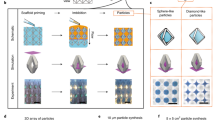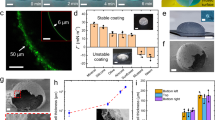Abstract
This study presents a fabrication method for spherical or ellipsoidal structures, achieved by using a liquid mold in a controlled manner. In order to verify this method, the physical relationship between liquid drops and pre-cured PDMS mixture was investigated during fabrication by altering properties such as density, viscosity, and surface tension. The results show that the lateral capillary force plays a critical role in fabricating hollow dome-like structures in a well-arranged array format. The degree of sphere of the fabricated structures was theoretically examined and was consistent with experimental data. This method is useful for fabricating hollow spherical structures with easy-to-fabricate protocols, and is affordable for general laboratories not equipped with conventional clean room facilities. Standard molding techniques for spherical structures are commonly cumbersome and difficult, since the removal process of the spherical rigid mold from the structure is almost impossible, or destructive to the fabrication. The current fabrication method uses a liquid fabrication mold, therefore providing a noninvasive means of forming spherical structures in pre-cured polymeric mixtures for micro- and meso-scale level applications. This method is also potentially beneficial for producing dynamic culture arrays with a sufficient supply of cell media to maintain controlled cellular environments that can directly induce stem cell differentiation and proliferation.





Similar content being viewed by others
References
Du Y, Lo E, Ali S, Khademhosseini A (2008) Directed assembly of cell-laden microgels for fabrication of 3D tissue constructs. Proc Natl Acad Sci USA 28:9522–9527
Grimes A, Breslauer DN, Long M, Pegan J, Lee LP, Khine M (2008) Shrinky–Dink microfluidics: rapid generation of deep and rounded patterns. Lab Chip 1:170–172
Hwang CM, Sim WY, Lee SH, Foudeh AM, Bae H, Khademhosseini A (2010) Benchtop fabrication of PDMS microstructures by an unconventional photolithographic method. Biofabrication 4:045001–045007
Kaigala GV, Ho S, Penterman R, Backhouse CJ (2007) Rapid prototyping of microfluidic devices with a wax printer. Lab Chip 3:384–387
Khademhosseini A, Langer R, Borenstein J, Vacanti JP (2006) Microscale technologies for tissue engineering and biology. Proc Natl Acad Sci USA 8:2480–2487
Lee JN, Park C, Whitesides GM (2003) Solvent compatibility of poly(dimethylsiloxane)-based microfluidic devices. Anal Chem 23:6544–6554
Lee DH, Park JY, Lee EJ, Choi YY, Kwon GH, Kim BM (2010a) Fabrication of three-dimensional microarray structures by controlling the thickness and elasticity of poly(dimethylsiloxane) membrane. Biomed Microdevices 1:49–54
Lee WG, Ortmann D, Hancock MJ, Bae H, Khademhosseini A (2010b) A hollow sphere soft lithography approach for long-term hanging drop methods. Tissue Eng Part C Methods 2:249–259
Liu X, Wang Q, Qin J, Lin B (2009) A facile “liquid-molding” method to fabricate PDMS microdevices with 3-dimensional channel topography. Lab Chip 9:1200–1205
Majidi C, Kramer R, Wood RJ (2011) A non-differential elastomer curvature sensor for softer-than-skin electronics. Smart Mater Struct 10:105017–105023
Park JY, Hwang CM, Lee SH (2009) Ice-lithographic fabrication of concave microwells and a microfluidic network. Biomed Microdevices 1:129–133
Qin D, Xia Y, Whitesides GM (2010) Soft lithography for micro- and nanoscale patterning. Nat Protoc 3:491–502
Shinto H, Komiyama D, Higashitani K (2006) Lateral capillary forces between solid bodies on liquid surface: a lattice Boltzmann study. Langmuir 5:2058–2064
Singh P, Joseph DD, Aubry N (2010) Dispersion and attraction of particles floating on fluid-liquid surfaces. Soft Matter 18:4310–4325
Sudarsan AP, Ugaz VM (2004) Printed circuit technology for fabrication of plastic-based microfluidic devices. Anal Chem 11:3229–3235
Tibbitt MW, Anseth KS (2009) Hydrogels as extracellular matrix mimics for 3D cell culture. Biotechnol Bioeng 4:655–663
Toh YC, Zhang C, Zhang J, Khong YM, Chang S, Samper VD, van Noort D, Hutmacher DW, Yu H (2007) A novel 3D mammalian cell perfusion-culture system in microfluidic channels. Lab Chip 3:302–309
Zamanian B, Masaeli M, Nichol JW, Khabiry M, Hancock MJ, Bae H, Khademhosseini A (2010) Interface-directed self-assembly of cell-laden microgels. Small 8:937–944
Acknowledgments
This work was supported by a grant from the Kyung Hee University in 2010 (KHU-20100608).
Author information
Authors and Affiliations
Corresponding author
Additional information
Y. Park and W. Y. Sim contributed equally to this work.
Electronic supplementary material
Below is the link to the electronic supplementary material.
542_2012_1690_MOESM1_ESM.tif
Figure S1 Graph for quantitative measurement of evaporation over time. This graph shows the rate of evaporation of different mixtures (TIFF 185 kb)
542_2012_1690_MOESM2_ESM.tif
Figure S2 Observation of lateral movements of liquid droplets of different materials. (a) Observation of lateral movements of droplets 80% ethanol and 100% distilled water at room temperature (RT). Ethanol droplets moved a bit more actively than those of distilled water. The inlet panels show photographs of liquid droplets submerged at PDMS surface with no entrance hole (top) and entrance hole (bottom). Scale bar is 1 cm, (b) Observation of a movement of droplets of 70% ethanol and 200-μL volume at RT. Scale bar is 5 mm. Note that the final positions of the ethanol droplets were dependent on the initial drop positions, resulting in directed 2D mesoscale self-assemblies of liquid droplets at the PDMS surface. (TIFF 953 kb)
542_2012_1690_MOESM3_ESM.tif
Figure S3 Characterization for geometrical formation of liquid droplet arrays (a) Plot for the distance between droplets in array, (b) Minor-axis diameters of the droplet arrays (TIFF 57 kb)
542_2012_1690_MOESM4_ESM.tif
Figure S4 Characterization for creation of liquid droplet arrays (N=19, 50 μL). (a) Photographs of fabrication of nineteen-droplet arrays with volume 50 μL. In our experiments, 80% ethanol has only a closely-packed array form, but not coalesced. The conditions below 20% ethanol were not in contact, while 40%, 60%, and 100% ethanol were coalesced. (b) Reversed images of the arrays for clear view. Scale bar is 1 cm. (TIFF 605 kb)
542_2012_1690_MOESM5_ESM.tif
Figure S5 Characterization for creation of liquid droplet arrays (N=7, 5 μL). (a) Photographs of fabrication of seven-droplet arrays with volume 5 μL. The experimental conditions were strongly affected by evaporation due to small volume and high volatility. The conditions below 40% ethanol were non-contact, in semi-contact at 60%, in contact at 80%, and totally evaporated at 100% where the black arrows indicate the spot for disappeared droplets. Note the experiment for fabricating nineteen-droplet arrays of using 5-μL volume was not performed here, because those droplets are too hard to fabricate due to its strong volatility. (b) Reversed images of the arrays for clear view. Scale bar is 1 cm. (TIFF 475 kb)
Rights and permissions
About this article
Cite this article
Park, Y., Sim, W.Y. & Lee, W.G. A controllable liquid mold for fabrication of 3D spherical structures and arrays. Microsyst Technol 18, 2093–2098 (2012). https://doi.org/10.1007/s00542-012-1690-y
Received:
Accepted:
Published:
Issue Date:
DOI: https://doi.org/10.1007/s00542-012-1690-y




